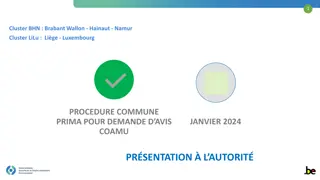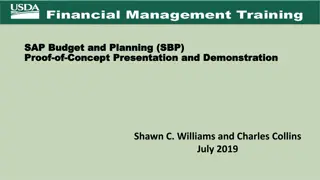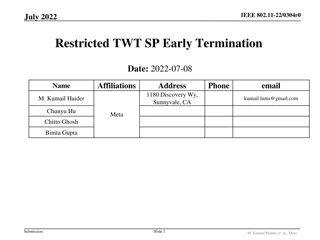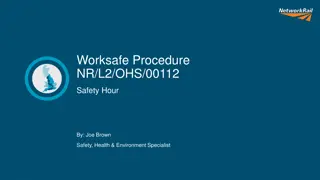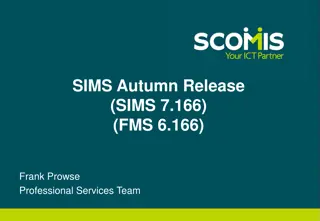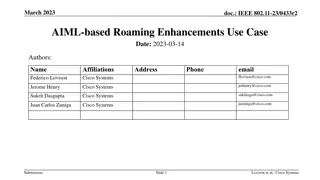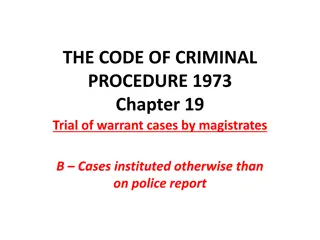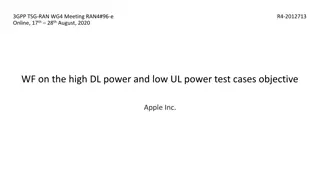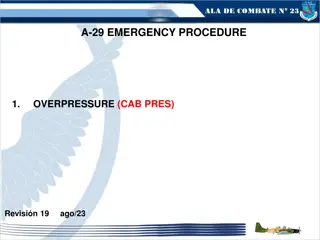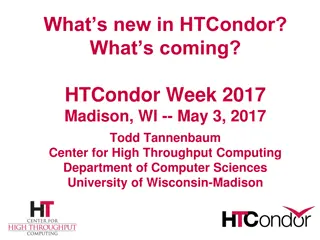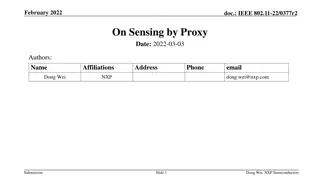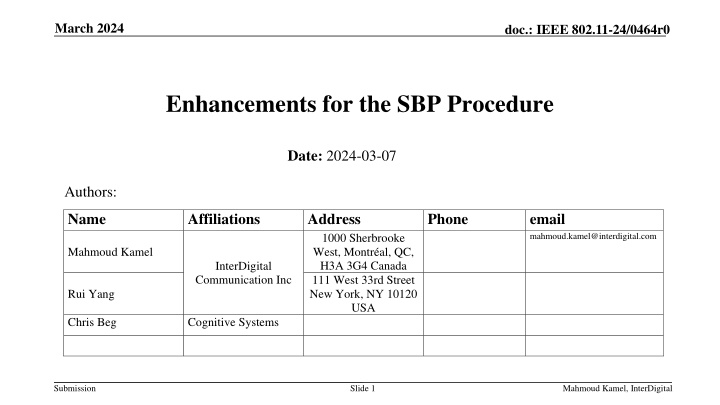
Enhancements for IEEE 802.11 SBP Procedure in March 2024
"Explore enhancements proposed for resolving limitations in the IEEE 802.11 SBP procedure, focusing on resolving CID 4296 issues related to the sensing measurement report transmission. The proposal suggests using a bitmap to indicate whether the SBP responder and other sensing responders should send the report. Detailed insights and resolutions are discussed in the document."
Download Presentation

Please find below an Image/Link to download the presentation.
The content on the website is provided AS IS for your information and personal use only. It may not be sold, licensed, or shared on other websites without obtaining consent from the author. If you encounter any issues during the download, it is possible that the publisher has removed the file from their server.
You are allowed to download the files provided on this website for personal or commercial use, subject to the condition that they are used lawfully. All files are the property of their respective owners.
The content on the website is provided AS IS for your information and personal use only. It may not be sold, licensed, or shared on other websites without obtaining consent from the author.
E N D
Presentation Transcript
March 2024 doc.: IEEE 802.11-24/0464r0 Enhancements for the SBP Procedure Date: 2024-03-07 Authors: Name Affiliations Address 1000 Sherbrooke West, Montr al, QC, H3A 3G4 Canada 111 West 33rd Street New York, NY 10120 USA Phone email mahmoud.kamel@interdigital.com Mahmoud Kamel InterDigital Communication Inc Rui Yang Chris Beg Cognitive Systems Submission Slide 1 Mahmoud Kamel, InterDigital
March 2024 doc.: IEEE 802.11-24/0464r0 Introduction In this contribution, we discuss a proposal to resolve CID 4296. The issue addressed in this CID is that the current specs for the SBP procedure have limitations: There is no way to indicate whether the preferred responders (including the SBP responder i.e., the AP) are required to send the sensing measurement reports to the SBP initiator or not without splitting the preferred responders to at least two groups and perform two SBP sessions. Furthermore, there are scenarios (one possible scenario is raised by the CID) where some roles cannot be assigned to the preferred responders (namely, the role of sensing transmitter and receiver). In other words, the allowed roles are either sensing transmitter or sensing receiver. Submission Slide 2 Mahmoud Kamel, InterDigital
March 2024 doc.: IEEE 802.11-24/0464r0 CID 4296 CID 4296 Clause 11.55.2.3 PP.LL 169.35 Comment Resolution Using only one bit (Sensing Measurement Report Requested field) to indicate whether the SBP responder (i.e., AP) and other sensing responders shall send the Sensing Measurement Report frames or not is insufficient and does not cover all cases. In the case where Preferred Responder Role Bitmap in the SBP Parameters element is set to 11 (i.e., Transmitter and Receiver), this responder may participate in NDPA sounding phase and TF sounding phase. This may result in a scenario where the responder can consume the sensing measurement report locally (no need to send the report), however, the AP measured the NDP transmitted by this responder and need to send the report back to the SBP initiator. If the Sensing Measurement Report Requested field is set to 0, this indicates that the AP shall not send the report and this measurement will be wasted. Use a bitmap to indicate to each of the responders with the role receiver or transmitter and receiver in the Sensing Responder Role Bitmap whether the report is requested or not. I will bring a contribution to address this issue. Submission Slide 3 Mahmoud Kamel, InterDigital
March 2024 doc.: IEEE 802.11-24/0464r0 Recap: SBP Procedure Submission Slide 4 Mahmoud Kamel, InterDigital
March 2024 doc.: IEEE 802.11-24/0464r0 Current Behavior Submission Slide 5 Mahmoud Kamel, InterDigital
March 2024 doc.: IEEE 802.11-24/0464r0 General Scenario In this scenario: STA 3 is a transmitter STA 4 and STA 5 are receivers STA 6 and STA 7 are transmitters and receivers STA 4 and STA 6 are required to send the sensing measurement report STA 5 and STA 7 are NOT required to send the sensing measurement report Sensing Measurement Request Submission Slide 6 Mahmoud Kamel, InterDigital
March 2024 doc.: IEEE 802.11-24/0464r0 Current Behavior for the General Scenario SBP Initiator in the previous scenario shall do the following : Split the 5 responders into two groups Group 1: includes all transmitters & all receivers that are required to send the sensing measurement report (STA 3, STA 4, STA 6) Group 2: includes all receivers that are NOT required to send the sensing measurement report (STA 5) Assign STA 7 the role of a transmitter and include it to Group 1 Start an SBP Procedure 1 with Group 1 Assign STA 7 the role of a receiver and include it to Group 2 Start an SBP Procedure 2 with Group 2 Submission Slide 7 Mahmoud Kamel, InterDigital
March 2024 doc.: IEEE 802.11-24/0464r0 Special Scenario STA 1: SBP Initiator, vendor sensing software compatible with STA 2/3 Configured as Sensing Receiver Does not require measurement report from STA 2/3 Requires measurement report from AP for STA 4/5 STA 2/3: Vendor sensing software compatible with STA 1 Locally consume and process CSI Configured as Sensing Receivers STA 4/5: No vendor sensing software Necessary for STA 1 to obtain Measurement Report Configured as Sensing Transmitters, AP generates report for STA 1 (STA 2) (STA 3) (AP) SBP Responder Local CSI Consumption (Vendor Sensing SW) (STA 1) SBP Initiator (STA 4) (STA 5) Local CSI Consumption + OTA Reports (Vendor Sensing SW) Measurement Report to STA 1 (No vendor Sensing SW) Submission Slide 8 Mahmoud Kamel, InterDigital
March 2024 doc.: IEEE 802.11-24/0464r0 Current Solution Overview Sensing Measurement Session ID=X Existing SPB signaling Only provides a single bit in the Sensing Measurement Parameters element (Sensing Measurement Report Requested) which currently applies to all sensing receivers. Sensing Measurement Request Sensing Measurement Response SBP Request SBP Response Within SBP Request frame, SBP Initiator: Includes only sensing receivers which deploy the vendor sensing software Set Sensing Measurement Report Requested = 0 (in Sensing Measurement Parameters) Sensing Measurement Session ID=Y Sensing Measurement Request SBP Request Sensing Measurement Response SBP Response To realize the above scenarios using existing SBP signaling SBP initiator would need to create two separate sessions, which will result in two separate exchanges Within SBP Request frame, SBP Initiator: Includes only sensing transmitters Set Sensing Measurement Report Requested = 1 (in Sensing Measurement Parameters) Sensing Measurement Session ID=Y Sensing Measurement Session ID=X Polling Phase NDPA Phase Polling Phase TF Phase SBP Reporting . . . No Report: Report to SBP Initiator: (STA4, STA5) (STA1, STA2, STA3) Submission Slide 9 Mahmoud Kamel, InterDigital
March 2024 doc.: IEEE 802.11-24/0464r0 Limitations of the Current Behavior for Both Scenarios Incurs complexity All complexity is in the non-AP STA side (i.e., the SBP initiator)! Negotiating twice will hold the media for longer time (more airtime) Less efficient in terms of channel usage No flexibility SBP Initiator has the ability to define Sensing RX / TX roles, however there is no way to signal measurement report is required. Current limitations require different SBP scenarios to be conducted using two separate Measurement Sessions. Submission Slide 10 Mahmoud Kamel, InterDigital
March 2024 doc.: IEEE 802.11-24/0464r0 Enhanced Solutions Overview Enhanced solutions Provide SBP initiator flexibility to specify in the SBP Request frame which sensing receivers need to provide report to SBP initiator, and which ones will locally consume measurement. Sensing Measurement Request SBP Request Sensing Measurement Response SBP Response Sensing Measurement Session ID=X Result in handling this scenario using a single SBP session, and all measurements occurring in a single exchange. SBP TF Phase Polling Phase NDPA Phase Reporting No Report: Report to SBP Initiator: (STA4, STA5) (STA1, STA2, STA3) Submission Slide 11 Mahmoud Kamel, InterDigital
March 2024 doc.: IEEE 802.11-24/0464r0 Changes to the Current Spec Draft Option 1 Include a bitmap (e.g., SM Report Requested Bitmap in the SBP Parameters element) where each bit in this bitmap indicates to the SBP responder (i.e., the AP) and each one of the responders in the Sensing Responder Role Bitmap with a receiving role whether the sensing measurement report is requested or not. Submission Slide 12 Mahmoud Kamel, InterDigital
March 2024 doc.: IEEE 802.11-24/0464r0 Changes to the Current Spec Draft Option 2 Include a bitmap (e.g., SM Report Requested Bitmap in the SBP Parameters element) where each bit in the bitmap indicates to each one of the responders in the Sensing Responder Role Bitmap with a receiving role whether the sensing measurement report is requested or not and use the Sensing Measurement Report Requested field in the Sensing Measurement Parameters element to indicate to the SBP Responder whether the sensing measurement report is requested or not. Submission Slide 13 Mahmoud Kamel, InterDigital
March 2024 doc.: IEEE 802.11-24/0464r0 Changes to the Current Spec Draft Option 3 Interpret Sensing Measurement Report Requested bit as being applied ONLY to sensing responder / sensing receivers. Add additional bit which applies to sensing initiator / sensing receiver (e.g., AP) to signal if AP should produce report for SBP initiator Submission Slide 14 Mahmoud Kamel, InterDigital
March 2024 doc.: IEEE 802.11-24/0464r0 Pros and Cons of the Enhancement Options Option 1 Option 2 Option 3 Add a bit to the Sensing Measurement Parameters element Changes to the specs Add a bitmap to the SBP Parameters element Add a bitmap to the SBP Parameters element Applicability General Scenarios General Scenarios Special Scenarios Does not allow responders with TxRx role Limitations No limitations No Limitations Enhancements to the SBP Procedure Flexibility, Simplicity, and Efficiency Flexibility, Simplicity, and Efficiency Flexibility, Simplicity, and Efficiency Submission Slide 15 Mahmoud Kamel, InterDigital
March 2024 doc.: IEEE 802.11-24/0464r0 Conclusions Simple changes to the current SBP negotiation procedure may enable a more flexible, simple and efficient SBP procedure. Flexibility allows the SBP initiator to selectively choose whether a sensing responder is required to send or not to send the sensing measurement reports (including the SBP responder, i.e., AP) Simplicity allows the SBP initiator to include all sensing responders in one SBP procedure Efficiency allows the SBP initiator to negotiate once for all sensing responders instead of negotiating twice, once for the responders that are required to send the report and once for the responders that are not required to send the report. This will save airtime Submission Slide 16 Mahmoud Kamel, InterDigital
March 2024 doc.: IEEE 802.11-24/0464r0 SP Which option do you prefer to enhance the SBP procedure? 1. Option 1 2. Option 2 3. Option 3 4. None of them 5. Abs Submission Slide 17 Mahmoud Kamel, InterDigital


